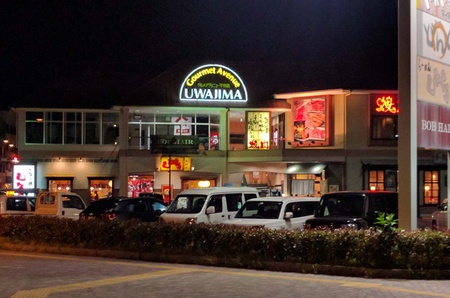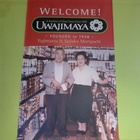The name of Seattle's Uwajiamaya comes from "Uwajima" in Uwajima City, located in the southwestern part of Ehime Prefecture. Uwajiamaya's founder, Fujimatsu Moriguchi, was originally from Kawakami Village, Nishiuwa District, Ehime Prefecture (now Kawakami Town, Yawatahama City), about 40 kilometers north by car from Uwajima City. He worked in Uwajima as a fishery processing worker in his youth during the Taisho era, and so he used the name Uwajima as the store name.
It is not clear what circumstances led Fujimatsu to come to Uwajima to train, but it may be that at the time, Uwajima was more prosperous in processed seafood products such as kamaboko and jakoten than neighboring towns such as Yawatahama, due to their large scale.
In 1921, the town of Uwajima in Kitauwa County and the village of Yawata merged to form the city of Uwajima, which would later become the city of Uwajima today. Meanwhile, Yawatahama City was established in 1935, but Kawakami Village continued to exist through the war, and was incorporated into Yawatahama City in 1955.
Seaside town
So, what kind of areas were Uwajima City and Yawatahama City? First, let's look at a map of Shikoku to confirm their geographical aspects. Ehime Prefecture faces the Seto Inland Sea all the way west from the border with Kagawa Prefecture. It continues to Niihama City, Imabari City, where the recently talked-about Kake Gakuen Veterinary School is located, and Matsuyama City, the prefectural capital.
Further west, you will eventually come to the northern coast of Yawatahama City, and beyond that, the long, narrow Sata Misaki Peninsula stretches out westward for about 40 kilometers in a jagged shape. Kyushu's Oita Prefecture is just a stone's throw away, across the Bungo Channel, and there is also a ferry route between Ehime and Oita. On the Seto Inland Sea side of the peninsula is the Shikoku Electric Power Ikata Nuclear Power Plant, which is currently out of operation.
On the other hand, on the southern side of the peninsula facing the Uwa Sea, it stretches from the north to Yawatahama, Seiyo, and Uwajima. The coastline is backed by mountains, and the mandarin orange fields that spread across the mountain slopes are typical of Ehime Prefecture.
Kamaboko and jacoten are local specialties in both Yawatahama and Uwajima. In particular, jacoten is known nationwide as a specialty of Uwajima and Yawatahama. Small fish, including firefly jacos (known as harambo), caught in the nearby seas, are ground into paste, including the skin and bones, flattened, cut into pieces, and deep-fried. In Uwajima, this is also called tempura. It is rich in calcium and minerals, and has been featured in the media in recent years as being good for your health.
In addition, "The origin of Uwajima kamaboko production dates back to 1615 (the first year of the Genwa era), when Date Hidemune was granted a fief in Uwajima and brought along a Sendai kamaboko craftsman to teach the manufacturing techniques" (Uwajima City Tourism and Products Association), so it has a long history and a truly traditional taste. It is characterized by its chewy texture.
Fujimatsu Moriguchi was involved in this traditional seafood processing industry in his youth. His knowledge of the techniques for making kamaboko and other fish paste products, which are familiar to most Japanese people living in a sea-stricken area, was probably an advantage when doing business with Japanese immigrants in America.
Another famous local dish in Uwajima is taimeshi (sea bream rice). There are versions of taimeshi in which sea bream is cooked together with rice, but in Uwajima, sashimi is dipped in a sauce made from soy sauce, dashi stock, egg yolk, etc., and then served on top of warm rice. It has been around for a long time as a type of "fisherman's meal."
Yawatahama is also proud of its seafood, and at the roadside station and port oasis "Yawatahama Minato" near the sea, there is "Doya Market", a direct sales store for seafood, and "Doya Shokudo", where you can eat. "Yawatahama Chanpon" is also a popular local delicacy.
(Titles omitted)
© 2018 Ryusuke Kawai









